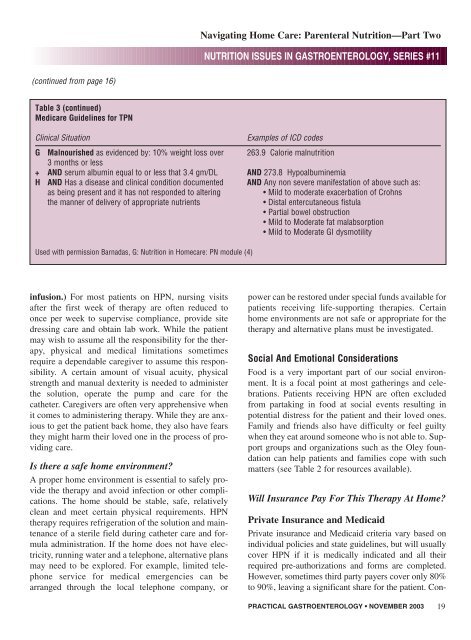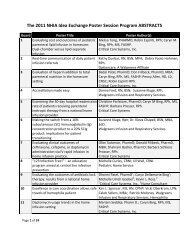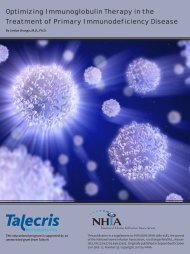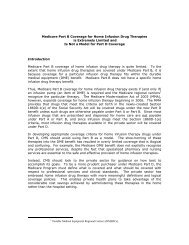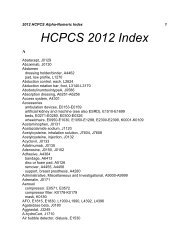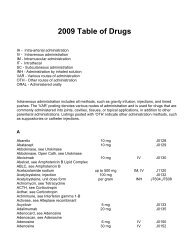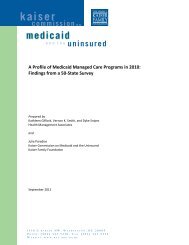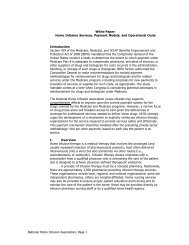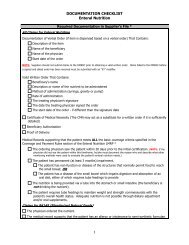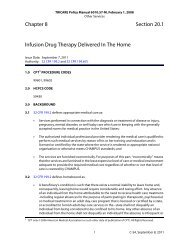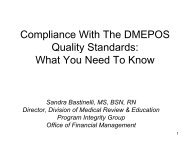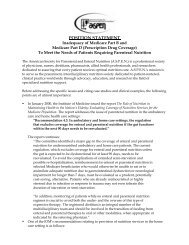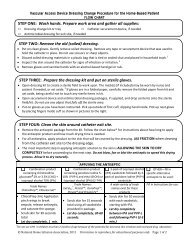Navigating Home Care: Parenteral Nutrition—Part Two
Navigating Home Care: Parenteral Nutrition—Part Two
Navigating Home Care: Parenteral Nutrition—Part Two
Create successful ePaper yourself
Turn your PDF publications into a flip-book with our unique Google optimized e-Paper software.
<strong>Navigating</strong> <strong>Home</strong> <strong>Care</strong>: <strong>Parenteral</strong> <strong>Nutrition—Part</strong> <strong>Two</strong><br />
NUTRITION ISSUES IN GASTROENTEROLOGY, SERIES #11<br />
(continued from page 16)<br />
Table 3 (continued)<br />
Medicare Guidelines for TPN<br />
Clinical Situation<br />
Examples of ICD codes<br />
G Malnourished as evidenced by: 10% weight loss over 263.9 Calorie malnutrition<br />
3 months or less<br />
+ AND serum albumin equal to or less that 3.4 gm/DL AND 273.8 Hypoalbuminemia<br />
H AND Has a disease and clinical condition documented AND Any non severe manifestation of above such as:<br />
as being present and it has not responded to altering<br />
• Mild to moderate exacerbation of Crohns<br />
the manner of delivery of appropriate nutrients<br />
• Distal entercutaneous fistula<br />
• Partial bowel obstruction<br />
• Mild to Moderate fat malabsorption<br />
• Mild to Moderate GI dysmotility<br />
Used with permission Barnadas, G: Nutrition in <strong>Home</strong>care: PN module (4)<br />
infusion.) For most patients on HPN, nursing visits<br />
after the first week of therapy are often reduced to<br />
once per week to supervise compliance, provide site<br />
dressing care and obtain lab work. While the patient<br />
may wish to assume all the responsibility for the therapy,<br />
physical and medical limitations sometimes<br />
require a dependable caregiver to assume this responsibility.<br />
A certain amount of visual acuity, physical<br />
strength and manual dexterity is needed to administer<br />
the solution, operate the pump and care for the<br />
catheter. <strong>Care</strong>givers are often very apprehensive when<br />
it comes to administering therapy. While they are anxious<br />
to get the patient back home, they also have fears<br />
they might harm their loved one in the process of providing<br />
care.<br />
Is there a safe home environment<br />
A proper home environment is essential to safely provide<br />
the therapy and avoid infection or other complications.<br />
The home should be stable, safe, relatively<br />
clean and meet certain physical requirements. HPN<br />
therapy requires refrigeration of the solution and maintenance<br />
of a sterile field during catheter care and formula<br />
administration. If the home does not have electricity,<br />
running water and a telephone, alternative plans<br />
may need to be explored. For example, limited telephone<br />
service for medical emergencies can be<br />
arranged through the local telephone company, or<br />
power can be restored under special funds available for<br />
patients receiving life-supporting therapies. Certain<br />
home environments are not safe or appropriate for the<br />
therapy and alternative plans must be investigated.<br />
Social And Emotional Considerations<br />
Food is a very important part of our social environment.<br />
It is a focal point at most gatherings and celebrations.<br />
Patients receiving HPN are often excluded<br />
from partaking in food at social events resulting in<br />
potential distress for the patient and their loved ones.<br />
Family and friends also have difficulty or feel guilty<br />
when they eat around someone who is not able to. Support<br />
groups and organizations such as the Oley foundation<br />
can help patients and families cope with such<br />
matters (see Table 2 for resources available).<br />
Will Insurance Pay For This Therapy At <strong>Home</strong><br />
Private Insurance and Medicaid<br />
Private insurance and Medicaid criteria vary based on<br />
individual policies and state guidelines, but will usually<br />
cover HPN if it is medically indicated and all their<br />
required pre-authorizations and forms are completed.<br />
However, sometimes third party payers cover only 80%<br />
to 90%, leaving a significant share for the patient. Con-<br />
PRACTICAL GASTROENTEROLOGY • NOVEMBER 2003 19


